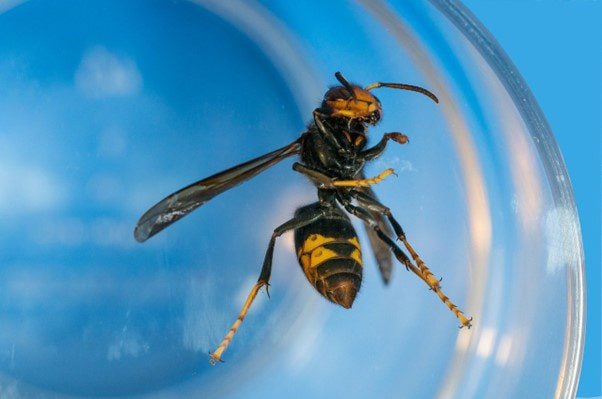Scientists in Switzerland have begun testing unusual weapons to protect honeybees from an invasive predator. On the hills above Cornol in the canton of Jura, researchers are deploying electric harps and protective “muzzles” to shield beehives from Asian hornets.
These yellow-legged hornets, known scientifically as Vespa velutina, first arrived in Europe through France in 2004. Since then, they’ve spread across the continent, reaching Switzerland where they pose a serious threat to bee populations.
“This is the first time such trials have been carried out in Switzerland,” says Dr. Lukas Seehausen, a research scientist at CABI’s Swiss Centre in Delémont. “We want real quantitative and qualitative data to see which method, if any, is worth recommending.”
The experiment uses nine beehives in Cornol, divided into three groups. Three hives have been fitted with electric harps – frames containing alternating positive and negative wires. When bees pass through, they typically touch only one wire and continue safely. But hornets, being larger, often touch two wires simultaneously and receive a fatal electric shock.
Another three hives have protective muzzles installed – wire fences placed at hive entrances where hornets typically hunt. These barriers block the predators while allowing bees to come and go freely. The final three hives remain unprotected as control subjects for comparison.
To ensure reliable results, this testing setup is replicated at nine different locations across the Jura canton.
Dr. Julie Hernandez, a honeybee specialist at the Fondation Rurale Interjurassienne (FRI), explains they’re using a method called “honeybee colony structure evaluation” to determine if these devices improve the health of bee colonies under attack.
The researchers will also examine whether these defensive measures affect native wildlife. Similar technology has already shown promising results in France and Spain, where electric harps reportedly killed hundreds of Asian hornets daily in heavily infested areas.
Similar Posts
However, Dr. Seehausen cautions that such dramatic results may not occur in Jura, where hornet populations are currently lower than in those regions.
Swiss scientists first confronted Asian hornets in 2020, when they tracked and destroyed a nest in Le Noirmont using radio telemetry. That same year marked the first recorded attacks on local beehives.
While Asian hornets aren’t more aggressive toward humans than native European hornets, they typically appear in greater numbers in invaded areas. Their sting can be dangerous for people with allergies.
For beekeepers, the main concern is the hornets’ relentless hunting of honeybees. A single Asian hornet can kill up to 30 European honeybees per day, as the European bees haven’t evolved defenses against this predator.
The threat extends beyond honey production. Bees play a crucial role in pollinating crops, and their decline due to hornet predation could negatively impact food production and biodiversity.
This Swiss trial is part of a larger project led by CABI, which aims to protect pollinators against the invasive Asian hornet and gather evidence on the most effective protection methods.



















